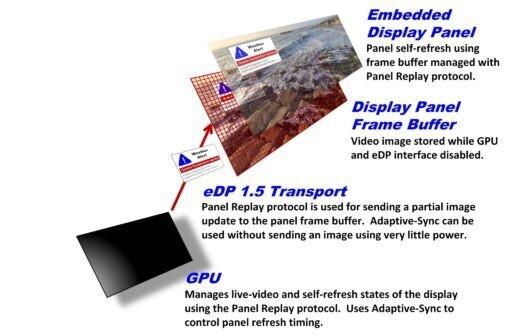VESA announced today that it has published the Embedded DisplayPort (eDP) Standard version 1.5. Replacing eDP 1.4b, published in 2015, eDP 1.5 retains all key features of the previous specification while adding additional capabilities and performance. These include an improved panel self-refresh protocol coupled with enhancements to VESA's Adaptive-Sync protocol, a combination that results in added power savings and improved motion image quality.
For devices such as laptop PCs with an embedded display, eDP is the electrical interface for transporting video data from the system's graphics hardware to the internal display panel. eDP is widely adopted for larger, higher-resolution displays as it provides the highest resolutions, refresh rates and color depths using a low wire count with low EMI radiation. Enhancements to the eDP standard have continued since its introduction more than 10 years ago, thanks to contributions by major OEMs through the VESA organization. eDP applications include laptops, all-in-one PCs, premium tablets, automotive displays, and other systems that incorporate a display panel with a video or graphics video source.
Improving power optimization
As with the previous spec version, eDP 1.5 supports panel self-refresh, a key power-saving feature in the standard. With panel self-refresh, static screen images are stored in the display memory while other parts of the system enter a low-power standby state. The system can momentarily awaken to update all or part of the display as needed. This offers significant power savings in typical PC or tablet usage applications. The panel self-refresh function was further optimized in eDP 1.5 with the addition of an enhanced Panel Replay protocol that provides even more power savings as well as improved display performance, including compatibility with Adaptive-Sync.
Other new protocols developed for eDP 1.5 include the ability to disable the display interface during normal operation (when not using panel self-refresh) during the vertical blanking period, which provides added power savings. eDP 1.5 also adds protocol support for new panel types, such as certain organic light emitting diode (OLED) panels, that feature extended display persistence and, thus, low refresh capability, without the need for a frame buffer.
Improving gaming and media playback performance
While eDP has long supported Adaptive-Sync for power saving and frame rate control for gaming, eDP 1.5 adds new Adaptive-Sync capabilities. For the playback of movies or video streaming, a new protocol was added to allow small frame rate adjustments to prevent skipping or repeated frames. For panels with a wide frame rate capability deployed in gaming systems, new mechanisms were added to reduce display flicker.
As with the previous spec version, eDP 1.5 continues to support the utilization of VESA's DisplayHDR and DisplayHDR True Black specifications - bringing vivid, life-like high dynamic range (HDR) content with the high color and contrast accuracy assured by these standards to embedded display applications.


